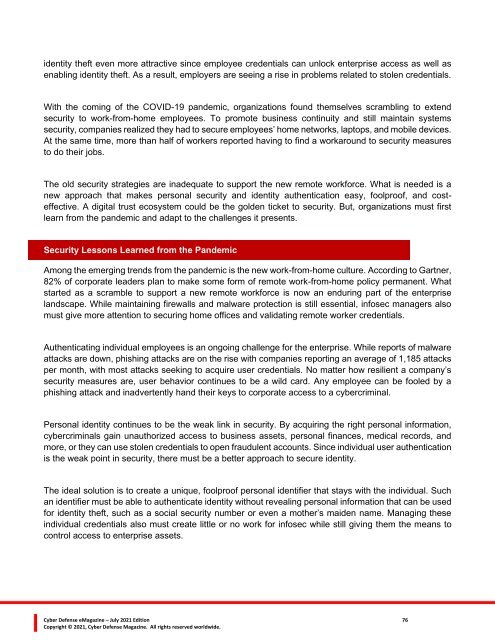Cyber Defense eMagazine July 2021 Edition
Cyber Defense eMagazine July Edition for 2021 #CDM #CYBERDEFENSEMAG @CyberDefenseMag by @Miliefsky a world-renowned cyber security expert and the Publisher of Cyber Defense Magazine as part of the Cyber Defense Media Group as well as Yan Ross, US Editor-in-Chief, Pieruligi Paganini, Co-founder & International Editor-in-Chief, Stevin Miliefsky, President and many more writers, partners and supporters who make this an awesome publication! Thank you all and to our readers! OSINT ROCKS! #CDM #CDMG #OSINT #CYBERSECURITY #INFOSEC #BEST #PRACTICES #TIPS #TECHNIQUES
Cyber Defense eMagazine July Edition for 2021 #CDM #CYBERDEFENSEMAG @CyberDefenseMag by @Miliefsky a world-renowned cyber security expert and the Publisher of Cyber Defense Magazine as part of the Cyber Defense Media Group as well as Yan Ross, US Editor-in-Chief, Pieruligi Paganini, Co-founder & International Editor-in-Chief, Stevin Miliefsky, President and many more writers, partners and supporters who make this an awesome publication! Thank you all and to our readers! OSINT ROCKS! #CDM #CDMG #OSINT #CYBERSECURITY #INFOSEC #BEST #PRACTICES #TIPS #TECHNIQUES
You also want an ePaper? Increase the reach of your titles
YUMPU automatically turns print PDFs into web optimized ePapers that Google loves.
identity theft even more attractive since employee credentials can unlock enterprise access as well as<br />
enabling identity theft. As a result, employers are seeing a rise in problems related to stolen credentials.<br />
With the coming of the COVID-19 pandemic, organizations found themselves scrambling to extend<br />
security to work-from-home employees. To promote business continuity and still maintain systems<br />
security, companies realized they had to secure employees’ home networks, laptops, and mobile devices.<br />
At the same time, more than half of workers reported having to find a workaround to security measures<br />
to do their jobs.<br />
The old security strategies are inadequate to support the new remote workforce. What is needed is a<br />
new approach that makes personal security and identity authentication easy, foolproof, and costeffective.<br />
A digital trust ecosystem could be the golden ticket to security. But, organizations must first<br />
learn from the pandemic and adapt to the challenges it presents.<br />
Security Lessons Learned from the Pandemic<br />
Among the emerging trends from the pandemic is the new work-from-home culture. According to Gartner,<br />
82% of corporate leaders plan to make some form of remote work-from-home policy permanent. What<br />
started as a scramble to support a new remote workforce is now an enduring part of the enterprise<br />
landscape. While maintaining firewalls and malware protection is still essential, infosec managers also<br />
must give more attention to securing home offices and validating remote worker credentials.<br />
Authenticating individual employees is an ongoing challenge for the enterprise. While reports of malware<br />
attacks are down, phishing attacks are on the rise with companies reporting an average of 1,185 attacks<br />
per month, with most attacks seeking to acquire user credentials. No matter how resilient a company’s<br />
security measures are, user behavior continues to be a wild card. Any employee can be fooled by a<br />
phishing attack and inadvertently hand their keys to corporate access to a cybercriminal.<br />
Personal identity continues to be the weak link in security. By acquiring the right personal information,<br />
cybercriminals gain unauthorized access to business assets, personal finances, medical records, and<br />
more, or they can use stolen credentials to open fraudulent accounts. Since individual user authentication<br />
is the weak point in security, there must be a better approach to secure identity.<br />
The ideal solution is to create a unique, foolproof personal identifier that stays with the individual. Such<br />
an identifier must be able to authenticate identity without revealing personal information that can be used<br />
for identity theft, such as a social security number or even a mother’s maiden name. Managing these<br />
individual credentials also must create little or no work for infosec while still giving them the means to<br />
control access to enterprise assets.<br />
<strong>Cyber</strong> <strong>Defense</strong> <strong>eMagazine</strong> – <strong>July</strong> <strong>2021</strong> <strong>Edition</strong> 76<br />
Copyright © <strong>2021</strong>, <strong>Cyber</strong> <strong>Defense</strong> Magazine. All rights reserved worldwide.


















